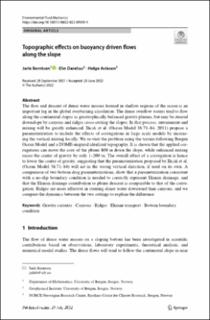| dc.contributor.author | Berntsen, Jarle Peder | |
| dc.contributor.author | Chiche, Elin Maria Kristina Darelius | |
| dc.contributor.author | Avlesen, Helge | |
| dc.date.accessioned | 2023-01-19T14:33:17Z | |
| dc.date.available | 2023-01-19T14:33:17Z | |
| dc.date.created | 2022-08-16T09:20:12Z | |
| dc.date.issued | 2022 | |
| dc.identifier.issn | 1567-7419 | |
| dc.identifier.uri | https://hdl.handle.net/11250/3044719 | |
| dc.description.abstract | The flow and descent of dense water masses formed in shallow regions of the ocean is an important leg in the global overturning circulation. The dense overflow waters tend to flow along the continental slopes as geostrophically balanced gravity plumes, but may be steered downslope by canyons and ridges cross-cutting the slopes. In that process, entrainment and mixing will be greatly enhanced. Ilicak et al. (Ocean Model 38:71–84, 2011) propose a parameterization to include the effects of corrugations in large scale models by increasing the vertical mixing locally. We re-visit the problem using the terrain-following Bergen Ocean Model and a DOME-inspired idealized topography. It is shown that the applied corrugations can move the core of the plume 800 m down the slope, while enhanced mixing raises the center of gravity by only 1–200 m. The overall effect of a corrugation is hence to lower the center of gravity, suggesting that the parameterization proposed by Ilicak et al. (Ocean Model 38:71–84) will act in the wrong vertical direction, if used on its own. A comparison of two bottom drag parameterizations, show that a parameterization consistent with a no-slip boundary condition is needed to correctly represent Ekman drainage, and that the Ekman drainage contribution to plume descent is comparable to that of the corrugation. Ridges are more effective in steering dense water downward than canyons, and we compare the dynamics between the two settings to explain the difference. | en_US |
| dc.language.iso | eng | en_US |
| dc.publisher | Springer | en_US |
| dc.rights | Navngivelse 4.0 Internasjonal | * |
| dc.rights.uri | http://creativecommons.org/licenses/by/4.0/deed.no | * |
| dc.title | Topographic effects on buoyancy driven flows along the slope | en_US |
| dc.type | Journal article | en_US |
| dc.type | Peer reviewed | en_US |
| dc.description.version | publishedVersion | en_US |
| dc.rights.holder | Copyright 2022 the authors | en_US |
| cristin.ispublished | true | |
| cristin.fulltext | original | |
| cristin.qualitycode | 1 | |
| dc.identifier.doi | 10.1007/s10652-022-09890-1 | |
| dc.identifier.cristin | 2043266 | |
| dc.source.journal | Environmental Fluid Mechanics | en_US |
| dc.identifier.citation | Environmental Fluid Mechanics. 2022. | en_US |

